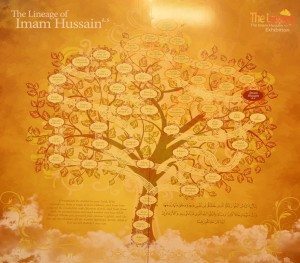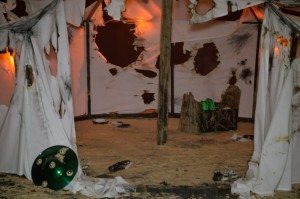It is said that one should commemorate the legacy of Karbala in any way to keep the message alive and what finer way than to take to the arts to do so. In a feat that is the first of its kind, the Hussain Legacy Exhibition has taken community by storm. Utilising several forms of media, art and creativity, it brings us with an unrivalled representation of the tragedy of Karbala.
 As you walk into the exhibition, you are faced with the family tree of Prophethood and Imamate, linking Prophet Adam (as) to Imam Hussain (as) and leading ultimately to the Awaited Saviour Imam Mahdi (as). This puts into perspective the lineage of the Imam and how it is that Prophets of all faiths link to the Imams.
As you walk into the exhibition, you are faced with the family tree of Prophethood and Imamate, linking Prophet Adam (as) to Imam Hussain (as) and leading ultimately to the Awaited Saviour Imam Mahdi (as). This puts into perspective the lineage of the Imam and how it is that Prophets of all faiths link to the Imams.
As you continue, you come across a visual representation of Imam Hussain’s (as) birth site, showing how close he lived to Prophet Mohammed (pbuh&hp), as well as other members of the Ahlulbayt and the companions of the Prophet. The model serves to put into perspective the close proximity of the Imam’s house to the mosque and serves as a reminder as to how difficult it was for him to leave his home and embark upon the journey towards Karbala.
Further on is one of my favourite parts of the exhibition, showcasing a larger than life bookshelf and handwritten pieces of parchment, bringing to light the works of an 8th century historian by the name of Abu Mikhnaf (Lut ibn Yahya). He was one of the reporters of the battle of Karbala. In this section, you can find Imam Hussain’s (as) traditions and attributes documented onto the scrolls.
As you move onwards, the organisers make use of digital technology and have created a documentary that highlights the main events that took place from the death of Prophet Mohammed (pbuh) till the death of Muslim ibn Aqeel. It allows you to reflect on the history behind the event of Karbala and what steps took Imam Hussain (as) to the site of his death.
The next section is something that I greatly enjoyed, learning a little more about the famed companions of the Imam (as). It gives us an insight into the lives of 8 of the companions: Aabis ibn Abu Shabib, Muslim ibn Awsaja, Hurr ibn Yazid al Riyahi, Zuhayr ibn al Qayn, John Al-Kalabi, Wahab ibn Abdullah, Burayr ibn Khuzay and Habib ibn Madhahir. This is something that I feel children would enjoy more and where they can learn more about the lives of these noble companions.
Further along and through a corridor, you reach a large hall that documents the steps taken by the Imam (as) and his family as he leaves from Madinah and heads towards Karbala. This section displays parts of his will to his brother as well as reminding us of where he was, the journey he undertook and how many days he was away from arriving in Karbala. Above all, the best part in this section is the miniature representation of the battle of Karbala itself. It clearly depicts the ratio of Yazid’s army in comparison to that of Imam Hussain (as).
 The last section of this exhibition is by far the most moving and touching- ‘the aftermath.’ As you walk into the darkened room, your senses are all brought to life, as you smell the acrid smell of burning fabric. Your eyes take in the state of the tent and the red lighting reminds you of how the tents of the Ahlulbayt were set alight after the martyrdom of Imam Hussain (as), his household and closest companions. Your heart is transported to the plains of Karbala and the screams reverberating from the speakers transport you to the demise of the Holy Household.
The last section of this exhibition is by far the most moving and touching- ‘the aftermath.’ As you walk into the darkened room, your senses are all brought to life, as you smell the acrid smell of burning fabric. Your eyes take in the state of the tent and the red lighting reminds you of how the tents of the Ahlulbayt were set alight after the martyrdom of Imam Hussain (as), his household and closest companions. Your heart is transported to the plains of Karbala and the screams reverberating from the speakers transport you to the demise of the Holy Household.
Throughout the walkways of the exhibition you will find the artwork of several well-known and newer artists who have been inspired to produce fine art, both using traditional materials and through digital media with the theme of Karbala.
I would strongly urge everyone to make use of the opportunity of visiting this exhibition and taking in the efforts of the organisers in recreating and teaching us about the story of Karbala. It is open everyday from 6pm and admittance is free; they welcome school visits and above all, people from all walks of life to learn about and live the experience of the Hussaini Legacy.
My deepest gratitude to Nebras Baraka for her walk through of the exhibition and Mariam Mansour for her assistance in photography. A special thank you to the organisers and security for allowing us to document the exhibition.
The Legacy: Imam Hussain (as) Exhibition
403 Edgware Road, London, NW2 6LN
































